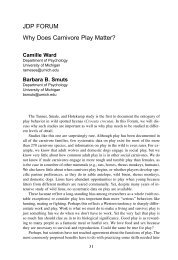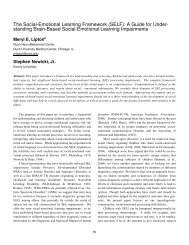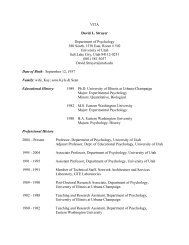Friendship and Friendship Quality in Middle Childhood ... - Psychology
Friendship and Friendship Quality in Middle Childhood ... - Psychology
Friendship and Friendship Quality in Middle Childhood ... - Psychology
Create successful ePaper yourself
Turn your PDF publications into a flip-book with our unique Google optimized e-Paper software.
Table 1<br />
Items <strong>and</strong> Subscales of the <strong>Friendship</strong> <strong>Quality</strong> Questionnaire<br />
Structure<br />
Subscale/item" coefficient<br />
Validation <strong>and</strong> Car<strong>in</strong>g (a = .90)<br />
15. Makes me feel good about my ideas<br />
4. Tells me I am good at th<strong>in</strong>gs<br />
6. Make each other feel important <strong>and</strong> special<br />
13. Tells me I am pretty smart<br />
8. Says "I'm sorry" if [he/she] hurts my<br />
feel<strong>in</strong>gs<br />
5. Sticks up for me if others talk beh<strong>in</strong>d my<br />
back<br />
10. Has good ideas about games to play<br />
41. Cares about my feel<strong>in</strong>gs<br />
12. Would like me even if others didn't<br />
30. Does not tell others my secrets<br />
Conflict Resolution (a = .73)<br />
26. Make up easily when we have a fight<br />
35. Get over our arguments really quickly<br />
11. Talk about how to get over be<strong>in</strong>g mad at<br />
each other<br />
Conflict <strong>and</strong> Betrayal (a = .84)<br />
20. Argue a lot<br />
27. Fight a lot<br />
3. Get mad a lot<br />
37. Doesn't listen to me<br />
31. Bug each other a lot<br />
9. Sometimes says mean th<strong>in</strong>gs about me to<br />
other kids<br />
21. Can count on to keep promises<br />
Help <strong>and</strong> Guidance (a = .90)<br />
34. Helps me so I can get done quicker<br />
39. Help each other with schoolwork a lot<br />
24. Gives advice with figur<strong>in</strong>g th<strong>in</strong>gs out<br />
36. Count on each other for good ideas on how<br />
to get th<strong>in</strong>gs done<br />
32. Come up with good ideas on ways to do<br />
th<strong>in</strong>gs<br />
33. Loan each other th<strong>in</strong>gs all the time<br />
28. Share th<strong>in</strong>gs with each other<br />
18. Do special favors for each other<br />
17. Help each other with chores a lot<br />
Companionship <strong>and</strong> Recreation (a = .75)<br />
2. Always sit together at lunch<br />
7. Always pick each other as partners for th<strong>in</strong>gs<br />
23. Always play together at recess<br />
19. Do fun th<strong>in</strong>gs together a lot<br />
22. Go to each others' houses<br />
Intimate Exchange (a = .86)<br />
14. Always tell each other our problems<br />
25. Talk about the th<strong>in</strong>gs that make us sad<br />
16. Talk to her when I'm mad about someth<strong>in</strong>g<br />
that happened to me<br />
40. Tell each other secrets<br />
38. Tell each other private th<strong>in</strong>gs<br />
29. Talk about how to make ourselves feel<br />
better if we are mad at each other<br />
FRIENDSHIP AND FRIENDSHIP QUALITY<br />
.783<br />
.780<br />
.729<br />
.703<br />
.695<br />
.662<br />
.644<br />
.635<br />
.595<br />
.547<br />
.880<br />
.840<br />
.573<br />
.844<br />
.822<br />
.782<br />
.696<br />
.652<br />
.638<br />
.635<br />
.823<br />
.768<br />
.757<br />
.744<br />
.702<br />
.640<br />
.595<br />
.576<br />
.567<br />
.802<br />
.728<br />
.690<br />
.660<br />
.571<br />
.755<br />
.740<br />
.709<br />
.690<br />
.674<br />
.653<br />
a Numbers are item numbers from the <strong>Friendship</strong> <strong>Quality</strong> Question-<br />
naire.<br />
<strong>in</strong>gs of lonel<strong>in</strong>ess <strong>and</strong> social dissatisfaction, uncontam<strong>in</strong>ated by their<br />
appraisals of the quality of their friendships, their perception of their<br />
social competence, or their estimate of the state of their current peer<br />
relationships. The <strong>in</strong>ternal consistency of this 3-item pure scale was a<br />
615<br />
= .11. The correlation between the pure lonel<strong>in</strong>ess scale <strong>and</strong> the larger,<br />
16-item scale was .84. Whenever lonel<strong>in</strong>ess <strong>and</strong> social dissatisfaction<br />
was analyzed <strong>in</strong> relation to measures of friendship quality, the 3-item<br />
pure lonel<strong>in</strong>ess scale was substituted for the 16-item measure, <strong>and</strong> this<br />
fact is noted accord<strong>in</strong>gly. For the sake of cont<strong>in</strong>uity with other research,<br />
scores for the larger scale were used <strong>in</strong> analyses <strong>in</strong> which the possibility<br />
of overlapp<strong>in</strong>g content was not an issue (i.e., <strong>in</strong> analyses that did not<br />
<strong>in</strong>volve friendship quality or friendship satisfaction).<br />
Procedure<br />
In the late fall, the parents of all children <strong>in</strong> the third through fifth<br />
grades of each participat<strong>in</strong>g school were mailed first-class letters describ<strong>in</strong>g<br />
the study. Parents were asked to contact either the pr<strong>in</strong>cipal or<br />
the experimenters if they did not want their child to participate or if<br />
they required more <strong>in</strong>formation about the study before decid<strong>in</strong>g. Data<br />
collection took place <strong>in</strong> three sessions <strong>in</strong> the w<strong>in</strong>ter <strong>and</strong> spr<strong>in</strong>g of the<br />
school year. Each session lasted about 1 hr. The first session began with<br />
an <strong>in</strong>troduction to the project <strong>and</strong> project staff. This <strong>in</strong>troduction<br />
stressed that participation was voluntary <strong>and</strong> confidential. After this,<br />
we adm<strong>in</strong>istered sociometric measures to assess peer acceptance <strong>and</strong><br />
to identify best friendships. Other measures were also adm<strong>in</strong>istered <strong>in</strong><br />
this session that are not relevant to the present study. In the second<br />
session, approximately 1 month later, the lonel<strong>in</strong>ess <strong>and</strong> social dissatisfaction<br />
questionnaire was adm<strong>in</strong>istered. In the third session, several<br />
weeks later, children's perception of the quality of their best friendship<br />
was assessed, as was their satisfaction with their friendship. All measures<br />
were group adm<strong>in</strong>istered <strong>in</strong> class, <strong>and</strong> each session was conducted<br />
by a different <strong>in</strong>vestigator to m<strong>in</strong>imize reactivity across sessions.<br />
Prelim<strong>in</strong>ary Analyses<br />
Results<br />
Prelim<strong>in</strong>ary analyses <strong>in</strong>dicated that children's grade level<br />
was not significantly related to any of the <strong>in</strong>dependent <strong>and</strong><br />
dependent variables under consideration. Furthermore, there<br />
were no <strong>in</strong>stances <strong>in</strong> which it was necessary to qualify any of the<br />
f<strong>in</strong>d<strong>in</strong>gs on the basis of grade. However, <strong>in</strong>clud<strong>in</strong>g grade did<br />
adversely affect the size of some cells <strong>in</strong> several analyses. For<br />
this reason, the analyses reported here are derived after collaps<strong>in</strong>g<br />
the data across grades.<br />
Prevalence of <strong>Friendship</strong><br />
Us<strong>in</strong>g the criterion of reciprocated best friendship, 77.6% of<br />
the children <strong>in</strong> this sample had at least one friend. However, as<br />
noted earlier, 484, or 54.9%, of the 881 children <strong>in</strong> the sample<br />
had very best friends. Thus, the narrow<strong>in</strong>g of the focus from<br />
best friendship to very best friendship had the impact of doubl<strong>in</strong>g<br />
the proportion of friendless children identified (45.1% vs.<br />
22.4%).<br />
Of primary <strong>in</strong>terest was the prevalence of best friendship<br />
among groups of children differ<strong>in</strong>g <strong>in</strong> level of acceptance. We<br />
expected that the likelihood of friendship would <strong>in</strong>crease as<br />
level of acceptance <strong>in</strong>creased but that many low-accepted children<br />
would nevertheless have friends. Logit analysis was used<br />
to model the odds of hav<strong>in</strong>g versus not hav<strong>in</strong>g a mutual best<br />
friend as a function of children's gender <strong>and</strong> level of acceptance.<br />
We evaluated the significance of <strong>in</strong>dividual terms (ma<strong>in</strong> effects





